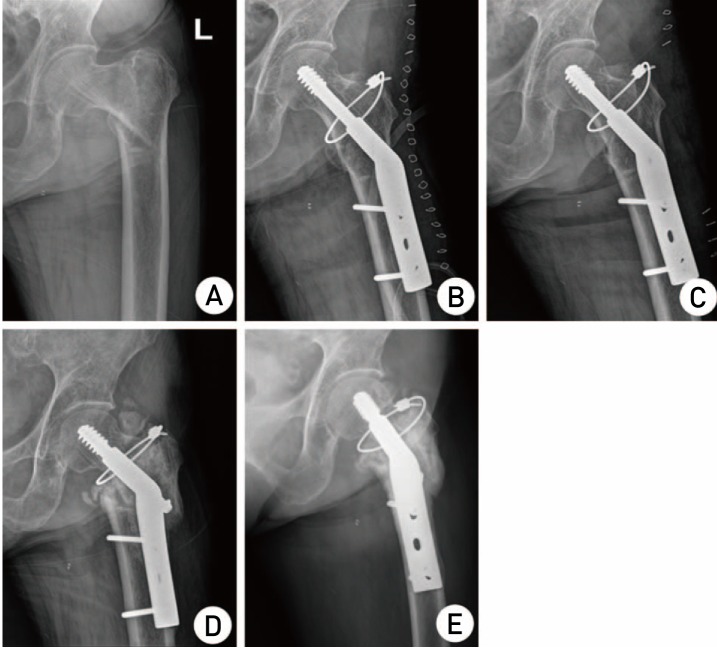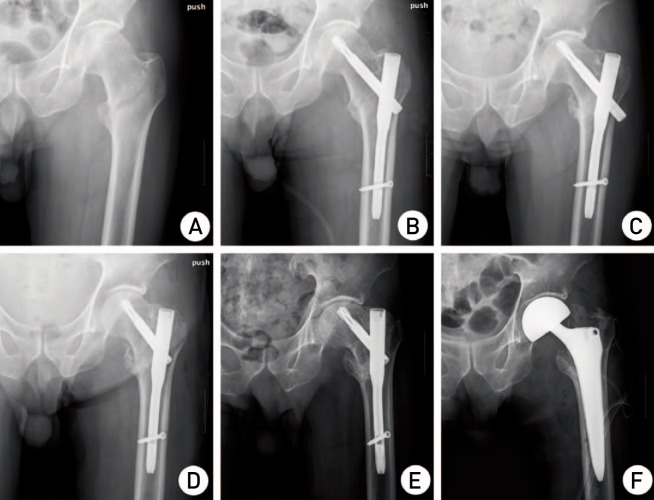Hip Pelvis.
2016 Dec;28(4):232-242. 10.5371/hp.2016.28.4.232.
Clinical and Functional Outcomes of Treatment for Type A1 Intertrochanteric Femoral Fracture in Elderly Patients: Comparison of Dynamic Hip Screw and Proximal Femoral Nail Antirotation
- Affiliations
-
- 1Department of Orthopedic Surgery, Gwangju Veterans Hospital, Gwangju, Korea. chm1228@hanmail.net
- KMID: 2364701
- DOI: http://doi.org/10.5371/hp.2016.28.4.232
Abstract
- PURPOSE
We aimed to evaluate and compare the clinical and functional outcomes of dynamic hip screw (DHS) and proximal femoral nail antirotation (PFNA) treatment of AO type 1 intertrochanteric fractures in elderly patients.
MATERIALS AND METHODS
We retrospectively reviewed 194 consecutive patients with type A1 intertrochanteric femoral fractures who were treated with DHS (n=113) or PFNA (n=81). We evaluated operation time, intraoperative blood loss, and functional outcomes, walking ability, and the Barthel activities index. Fracture union, sliding of hip screw, proximal femur shortening, and presence of complications were assessed radiologically at relevant follow-up intervals.
RESULTS
The mean operation time and blood loss were significantly lower for the PFNA group, but walking ability and Barthel index decreased to a similar extent for both groups. However, patients in the DHS group complained of significantly more pain (P=0.049). Although there were no significant differences between the two groups with respect to the time until fracture union was achieved, patients in the DHS group exhibited a higher extent of proximal femoral shortening and sliding of the hip screw. Differences about hip screw sliding and proximal femur shortening within each subgroup were not significant.
CONCLUSION
Compared to DHS treatment, PFNA treatment of type A1 intertrochanteric fractures is associated with reduced blood loss, shorter operation time, and less severe pain after surgery. Additionally, sliding of the hip screw and proximal femur shortening are expected to occur more frequently after DHS.
MeSH Terms
Figure
Cited by 1 articles
-
The Determination of Optimal Entry Point for Proximal Femoral Nail Antirotation-II by Fluoroscopic Simulation: A Cadaveric Study
Jin-Hoon Jeong, Gu-Hee Jung
J Korean Fract Soc. 2017;30(4):173-179. doi: 10.12671/jkfs.2017.30.4.173.
Reference
-
1. Siegmeth AW, Gurusamy K, Parker MJ. Delay to surgery prolongs hospital stay in patients with fractures of the proximal femur. J Bone Joint Surg Br. 2005; 87:1123–1126. PMID: 16049251.
Article2. Rao JP, Banzon MT, Weiss AB, Rayhack J. Treatment of unstable intertrochanteric fractures with anatomic reduction and compression hip screw fixation. Clin Orthop Relat Res. 1983; (175):65–71.
Article3. Hardy DC, Descamps PY, Krallis P, et al. Use of an intramedullary hip-screw compared with a compression hip-screw with a plate for intertrochanteric femoral fractures. A prospective, randomized study of one hundred patients. J Bone Joint Surg Am. 1998; 80:618–630. PMID: 9611022.
Article4. Kumar R, Singh RN, Singh BN. Comparative prospective study of proximal femoral nail and dynamic hip screw in treatment of intertrochanteric fracture femur. J Clin Orthop Trauma. 2012; 3:28–36. PMID: 25983453.
Article5. Kaplan K, Miyamoto R, Levine BR, Egol KA, Zuckerman JD. Surgical management of hip fractures: an evidence-based review of the literature. II: intertrochanteric fractures. J Am Acad Orthop Surg. 2008; 16:665–673. PMID: 18978289.
Article6. Parker MJ, Handoll HH. Gamma and other cephalocondylic intramedullary nails versus extramedullary implants for extracapsular hip fractures in adults. Cochrane Database Syst Rev. 2005; (4):CD000093. PMID: 16235272.
Article7. Kregor PJ, Obremskey WT, Kreder HJ, Swiontkowski MF. Evidence-Based Orthopaedic Trauma Working Group. Unstable pertrochanteric femoral fractures. J Orthop Trauma. 2005; 19:63–66. PMID: 15668589.8. Koval KJ, Aharonoff GB, Rosenberg AD, Bernstein RL, Zuckerman JD. Functional outcome after hip fracture. Effect of general versus regional anesthesia. Clin Orthop Relat Res. 1998; (348):37–41. PMID: 9553531.9. Mahoney FI, Barthel DW. Functional evaluation: the Barthel index. Md State Med J. 1965; 14:61–65.10. Madsen JE, Naess L, Aune AK, Alho A, Ekeland A, Strømsøe K. Dynamic hip screw with trochanteric stabilizing plate in the treatment of unstable proximal femoral fractures: a comparative study with the Gamma nail and compression hip screw. J Orthop Trauma. 1998; 12:241–248. PMID: 9619458.
Article11. Cleveland M, Bosworth DM, Thompson FR, Wilson HJ Jr, Ishizuka T. A ten-year analysis of intertrochanteric fractures of the femur. J Bone Joint Surg Am. 1959; 41-A:1399–1408. PMID: 13849408.
Article12. Lorich DG, Geller DS, Nielson JH. Osteoporotic pertrochanteric hip fractures: management and current controversies. Instr Course Lect. 2004; 53:441–454. PMID: 15116633.13. Verhofstad MH, van der Werken C. DHS osteosynthesis for stable pertrochanteric femur fractures with a two-hole side plate. Injury. 2004; 35:999–1002. PMID: 15351666.
Article14. Kim WY, Han CH, Park JI, Kim JY. Failure of intertrochanteric fracture fixation with a dynamic hip screw in relation to pre-operative fracture stability and osteoporosis. Int Orthop. 2001; 25:360–362. PMID: 11820441.
Article15. Baumgaertner MR, Solberg BD. Awareness of tip-apex distance reduces failure of fixation of trochanteric fractures of the hip. J Bone Joint Surg Br. 1997; 79:969–971. PMID: 9393914.
Article16. Babst R, Renner N, Biedermann M, et al. Clinical results using the trochanter stabilizing plate (TSP): the modular extension of the dynamic hip screw (DHS) for internal fixation of selected unstable intertrochanteric fractures. J Orthop Trauma. 1998; 12:392–399. PMID: 9715446.
Article17. Brunner A, Jöckel JA, Babst R. The PFNA proximal femur nail in treatment of unstable proximal femur fractures--3 cases of postoperative perforation of the helical blade into the hip joint. J Orthop Trauma. 2008; 22:731–736. PMID: 18978550.
Article18. Kaufer H. Mechanics of the treatment of hip injuries. Clin Orthop Relat Res. 1980; (146):53–61. PMID: 7371269.
Article19. Ekström W, Miedel R, Ponzer S, Hedström M, Samnegård E, Tidermark J. Quality of life after a stable trochanteric fracture--a prospective cohort study on 148 patients. J Orthop Trauma. 2009; 23:39–44. PMID: 19104302.
Article20. Setiobudi T, Ng YH, Lim CT, Liang S, Lee K, Das De S. Clinical outcome following treatment of stable and unstable intertrochanteric fractures with dynamic hip screw. Ann Acad Med Singapore. 2011; 40:482–487. PMID: 22206063.
- Full Text Links
- Actions
-
Cited
- CITED
-
- Close
- Share
- Similar articles
-
- Comparison of the Compression Hip Screw (CHS) and the Proximal Femoral Nail Antirotation (PFNA) for Intertrochanteric Femoral Fracture
- Treatment of Femoral Intertrochanteric Fracture with Proximal Femoral Nail
- Treatment of Intertrochanteric Fracture with Proximal Femoral Nail
- Mid-term Results of Patients with Femoral Intertrochanteric Fractures Treated with Proximal Femoral Nail Antirotation
- Treatment of Unstable Intertrochanteric Fractures: A Comparison of Proximal Femoral Nail and Dynamic Hip Screw



